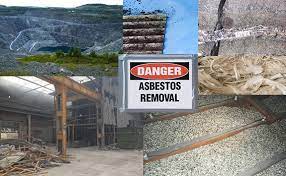Why is asbestos dangerous?
Asbestos is a natural substance that can be found in rocks and soil. The mineral fibre’s durability and resistance to heat allow it to be used in several different ways, like as an insulation component in construction materials and also as non-flammable material.
Being exposed to asbestos can have serious, adverse effects on your health. Asbestos exposure can increase your chances of developing lung cancer. Mesothelioma, or cancer of the mesothelial tissue, can develop after being exposed to asbestos. And it can take years for symptoms related to the exposure to appear.
Working with asbestos is a risk factor for developing mesothelioma. When working in a space with asbestos exposure, it is highly recommended to wear a face mask.
Unfortunately asbestos is still all around us in buildings and some products. If you’re not careful its exposure can lead to chronic disease or cancer.
What Is Asbestos and Why Is It Potentially Harmful?
You probably have heard people warn about the negative impact asbestos can have on your health. But what exactly is it?
Asbestos is a natural substance that can be found in rocks and soil. The mineral fibre’s durability and resistance to heat allow it to be used in several different ways, like as an insulation component in construction materials and also as non-flammable material.
Being exposed to asbestos can have serious, adverse effects on your health. Asbestos exposure can increase your chances of developing lung cancer. Mesothelioma, or cancer of the mesothelial tissue, can develop after being exposed to asbestos. And it can take years for symptoms related to the exposure to appear.
Working with asbestos is a risk factor for developing mesothelioma. When working in a space with asbestos exposure, it is highly recommended to wear a face mask.
 The lung disease asbestosis is not cancerous but is a chronic illness that is also linked to being exposed to asbestos. By inhaling asbestos’ microscopic fibres and dust, you can scar the tissues in your lungs. Unfortunately, decades can pass before people realise they have asbestosis, and the condition is irreversible. The longer you have been exposed to asbestos, the worse the impact of this disease.
The lung disease asbestosis is not cancerous but is a chronic illness that is also linked to being exposed to asbestos. By inhaling asbestos’ microscopic fibres and dust, you can scar the tissues in your lungs. Unfortunately, decades can pass before people realise they have asbestosis, and the condition is irreversible. The longer you have been exposed to asbestos, the worse the impact of this disease.
What Is Asbestos and Why Is It Potentially Harmful?
Smoking cigarettes is not good for your health and can also exacerbate the effects of being exposed to asbestos. Cigarette smoke can cause problems in your lung passages and can make it more difficult for your lungs to get rid of asbestos’ pesky fibers.
With a vigilant eye and taking the proper precautions, you can prevent health ailments related to asbestos exposure. Your lung health matters more than you may know.
Why is asbestos dangerous?
Asbestos still kills around 5000 workers each year, this is more than the number of people killed on the road.
Around 20 tradesman die each week as a result of past exposure
However, asbestos is not just a problem of the past. It can be present today in any building built or refurbished before the year 2000.
When materials that contain asbestos are disturbed or damaged, fibres are released into the air. When these fibres are inhaled they can cause serious diseases. These diseases will not affect you immediately; they often take a long time to develop, but once diagnosed, it is often too late to do anything. This is why it is important that you protect yourself now.
Asbestos can cause the following fatal and serious diseases:
Mesothelioma
Mesothelioma is a cancer which affects the lining of the lungs (pleura) and the lining surrounding the lower digestive tract (peritoneum). It is almost exclusively related to asbestos exposure and by the time it is diagnosed, it is almost always fatal.
Asbestos-related lung cancer
Asbestos-related lung cancer is the same as (looks the same as) lung cancer caused by smoking and other causes. It is estimated that there is around one lung cancer for every mesothelioma death.
Asbestosis
Asbestosis is a serious scarring condition of the lung that normally occurs after heavy exposure to asbestos over many years. This condition can cause progressive shortness of breath, and in severe cases can be fatal.
Pleural thickening
Pleural thickening is generally a problem that happens after heavy asbestos exposure. The lining of the lung (pleura) thickens and swells. If this gets worse, the lung itself can be squeezed, and can cause shortness of breath and discomfort in the chest.
When is Asbestos Dangerous?
The most common way for asbestos fibres to enter the body is through breathing. In fact, asbestos containing material is not generally considered to be harmful unless it is releasing dust or fibres into the air where they can be inhaled or ingested. Many of the fibres will become trapped in the mucous
membranes of the nose and throat where they can then be removed, but some may pass deep into the lungs, or, if swallowed, into the digestive tract. Once they are trapped in the body, the fibres can cause health problems. try using Asbestos Removal Melbourne
Asbestos is most hazardous when it is friable. The term “friable” means that the asbestos is easily crumbled by hand, releasing fibres into the air. Asbestos-containing ceiling tiles, floor tiles, undamaged laboratory cabinet tops, shingles, fire doors, siding shingles, etc. are not highly friable and will not
typically release asbestos fibres unless they are disturbed or damaged in some way.
Health Effects
Since it is difficult to destroy asbestos fibres, the body cannot break them down or remove them once They are lodged in lung or body tissues. There are three primary diseases associated with asbestos
Exposure:
Asbestosis
Asbestosis is a serious, chronic, non-cancerous respiratory disease. Inhaled asbestos fibres aggravate lung tissues, which cause them to scar. The risk of asbestosis is minimal for those who do not work with asbestos; the disease is rarely caused by neighbourhood or family exposure. Those who renovate or demolish buildings that contain asbestos may be at significant risk, depending on the nature of the exposure and precautions taken.
Lung Cancer
Lung cancer causes the largest number of deaths related to asbestos exposure. The incidence of lung cancer in people who are directly involved in the mining, milling, manufacturing and use of asbestos and its products are much higher than in the general population. People who have been exposed to asbestos and are also exposed to some other carcinogen — such as cigarette smoke – have a significantly greater risk of developing lung cancer than people who have only been exposed to asbestos. One study found that asbestos workers who smoke are about 90 times more likely to develop lung cancer than people who neither smoke nor have been exposed to asbestos.
Mesothelioma
Mesothelioma is a rare form of cancer that most often occurs in the thin membrane lining of the lungs, chest, abdomen, and (rarely) heart. Although Ativan is said to work very fast and helps you calm down when you have a seizure, it’s not really instant. If you’re someone who’s at the risk of having a seizure at any time. People who work in asbestos mines, asbestos mills and factories, and shipyards that use asbestos, as well as people who manufacture and install asbestos insulation, have an increased risk of mesothelioma. So do people who live with asbestos workers, near asbestos mining areas, near asbestos product factories or near shipyards where use of asbestos has produced large quantities of airborne asbestos fibres.
Other Cancers
Evidence suggests that cancers in the oesophagus, larynx, oral cavity, stomach, colon and kidney may be caused by ingesting asbestos. For more information on asbestos-related cancers, contact your local
chapter of the American Cancer Society.
Reference-
Thank you for reading this information about asbestos, we have written an article on the best 30 “Asbestos Removal Melbourne” Companies. Please take a read.
https://www.asbestossafety.gov.au/







